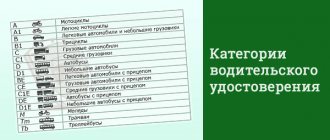The job description of a truck driver is used to specify the clauses of the employment contract. The requirements for an employment contract, enshrined in Article 57 of the Labor Code, do not require the employer to explain its clauses. But it often happens that both the employee and the employer require a more detailed explanation of the provisions of the employment contract. To resolve this issue, a job description is used, which can be created either as an annex to an employment contract or as a local regulatory act.
FILES
Truck driver job description sample
General provisions
- In the course of performing his duties, the truck driver is subordinate to the head of the transport department.
- A candidate for this position must meet the following qualification requirements:
- completed secondary education;
- At least 1 year of truck driving experience;
- Valid driver's license category "C".
- A truck driver must know:
- safety standards for the transportation of goods, as well as for driving a truck;
- current traffic regulations;
- standards for filling out and checking waybills, invoices and other required documents;
- standards for assessing the quality of his work;
- the brands of trucks used, their features and differences;
- specifics of transportation of various types of cargo;
- standards for cargo placement, loading, unloading, and securing;
- standards for preventing truck malfunctions;
- methods for prompt repair of truck parts;
- rules for caring for your truck, as well as its maintenance;
- the procedure for servicing trucks in garages, as well as storing them in parking lots;
- rules for handling the truck navigation system, as well as other electronic equipment;
- purpose and principles of operation of the main components of the machine;
- rules for checking trucks before leaving the highway;
- standards of care for issued protective clothing.
- The truck driver is guided by the following provisions:
- current legislation;
- traffic rules and acts regulating the transportation of goods;
- company documentation;
- information from this manual.
- During the absence of a truck driver, his transportation functions are transferred to another driver selected by the head of the transport department.
Functions
Responsibilities of a Truck Driver:
- Ensuring the integrity and timely transportation of the required goods.
- Ensuring that loads are properly placed in the bed or trailer and that they are properly secured.
- Ensuring that the vehicle is refilled with fuel and other ingredients in a timely manner.
- Prompt truck repair within our competence.
- Monitoring the replacement of tires and worn parts.
- Operate truck navigation system as well as other electronic equipment.
- Informing management about possible problems with the machine or its components.
- Parking the car or for repairs in the garage.
- Monitoring the quality of repair work on the truck.
- Monitoring the situation with carrying out preventive measures for the truck, as well as its testing.
- Keeping the truck clean and in good condition.
- Compliance with traffic regulations and fire safety regulations.
- Storage of workwear and other issued equipment.
- Filling out the required documents and checking their correctness.
Responsibility
A truck driver may have the following responsibilities:
- For violations of traffic rules and current laws committed during the performance of work - in accordance with the norms of current legislation.
- For improper performance of one's duties - in accordance with company standards, within the limits given in labor legislation.
- For damage caused to the company due to their incompetent actions - in accordance with the rules of the company, within the limits specified in the relevant paragraphs of legislation.
Rights
Set of rights for a truck driver:
- Making proposals to the head of the transport department to improve their work processes.
- Obtaining from company employees information required in their activities.
- Receiving from the employer special clothing for work, as well as other required equipment within the limits specified in the company documents.
- Refuse to drive a truck if it is not in a roadworthy condition.
- Require the head of the transport department to provide the vehicle with spare parts and necessary materials, as well as to carry out timely repairs.
Working conditions
- The truck driver receives additional benefits when working in the northern regions.
- Bonuses are provided to the driver based on the results of the year and quarter, as he fulfills the transportation plans, which are specified in the relevant company documentation.
- The driver is given clothing for work, and other equipment may also be issued in the manner prescribed in the relevant company documentation.
- During long flights, the employee is given cash for current expenses in accordance with the company's rules.
I. General provisions
1.1. The driver of the vehicle belongs to the category of technical performers. He is hired and dismissed by order of the director of the enterprise upon the recommendation of [fill in what is required].
1.2. The driver of the vehicle reports directly to [fill in as appropriate].
1.3. In his activities, the driver of the vehicle is guided by:
— rules of the road and technical operation of the vehicle;
— regulatory and methodological documents on the work performed;
— Charter of motor transport;
— the charter of the enterprise;
— internal labor regulations;
— orders and instructions from the immediate supervisor;
- this job description.
1.4. The driver of the vehicle must know:
— purpose, structure, principle of operation and operation of units, mechanisms and devices of serviced vehicles;
— rules of the road and technical operation of the vehicle;
— causes, methods of detecting and eliminating malfunctions that arose during operation;
— the procedure for carrying out maintenance and rules for storing a vehicle in garages and open parking lots;
— rules for operating batteries and car tires;
— rules for running in new cars and after major repairs;
— rules for the transportation of perishable and dangerous goods;
— the influence of weather conditions on the safety of driving a vehicle;
— ways to prevent road accidents;
— installation of radio installations and composters;
— rules for supplying buses for boarding and disembarking passengers;
— procedure for emergency evacuation of passengers in case of road accidents;
— rules for filling out primary documents to record the operation of serviced vehicles;
— volumes, frequency and basic rules for performing transport maintenance work;
— ways to increase vehicle mileage between repairs;
— features of the organization of technical maintenance and repair of vehicles in the field;
— ways to increase tire mileage and battery life;
— rules for using radio communications in transport;
— features of the organization of intercity transportation.
1.5. During the absence of the vehicle driver (vacation, illness, business trip, etc.), his duties are performed by a deputy appointed in the prescribed manner, who bears full responsibility for their proper performance.
What are the instructions for?
For the employing company, the document is required as an annex to the employment contract, specifying the points mentioned there.
For the employee, the contents of the instructions allow you to determine the main points of work, which allows you not to be distracted by communication with your boss.
Consequently, this document serves as a means of preventing official conflicts. And as a legally significant document, a job description can be used in judicial and pre-trial proceedings.
Rights
The driver of the car has the right: - to demand from management to provide the organizational and technical conditions necessary for the performance of official duties; — demand from the head of the department assistance in the performance of his official duties and rights; — require passengers to comply with the traffic rules (fasten a seat belt, board and disembark in permitted places, etc.); — receive information to the extent necessary to solve assigned tasks; — present to management proposals aimed at improving the safety and accident-free operation of the vehicle; - make decisions independently within your competence.
Features of the job description
There are no requirements in labor legislation for the preparation of job descriptions. Therefore, employers have great opportunities to adapt the document to their needs. Nevertheless, there are certain business standards that they try to adhere to when drawing up instructions. Thus, a typical job description includes the following parts:
- General provisions.
- Functions of a specialist.
- Labor rights.
- Responsibility measures for a specialist.
To these four basic sections, employers can add the following:
- Working conditions.
- Official connections.
- Principles for assessing a specialist.
- Qualification requirements.
The larger the employer and the more employees, the more sense it makes to include additional sections that prevent possible conflicts and misunderstandings.
General provisions
A basic section that describes general operating provisions. These include:
- who will temporarily replace the driver;
- to whom does the driver report?
- who makes decisions on hiring and firing a driver;
- what guides the driver;
- driver qualifications and knowledge required from him.
Particularly important are the paragraphs that list the qualification requirements for a given position, as well as the skill requirements that must be related to the functions listed below.
Attention! If a driver is required for a truck of a certain brand or a certain carrying capacity, then this should be separately mentioned in the list of skills.
Functions
The section includes both typical duties of the driver of any car, as well as those that the truck driver must perform. The first group includes refueling the car, caring for it, and the like. The second group includes the transportation of goods, checking their condition and configuration, and other specific things. The section necessarily mentions compliance with traffic rules and safety rules.
Important! If the driver is issued branded clothing for work, then the duty to care for it should be mentioned in a separate paragraph.
Responsibility
The section includes 3-4 points that describe violations for which the truck driver may be held liable. The description is given in a general manner, without mentioning specific penalties, since the degree of responsibility is determined during proceedings, including judicial proceedings, with all the nuances clarified.
Rights
The section is reserved for listing the rights of a truck driver. Typically, this includes 5-6 standard points, such as the right to receive information, the right to make proposals for improving work, and others. If the employer provides the driver with benefits, such as special clothing and retraining payments, then this section should be mentioned in a separate paragraph.
Working conditions
Truck driver is a profession that requires the employee not only to be qualified and possess certain skills, but also to be responsible, accurate and other qualities. Such employees are valued by the employer, which is emphasized with a special section that lists benefits and incentives for drivers. These conditions are prescribed on the basis of labor legislation, but can be expanded by the employer beyond the required minimum.
For a truck driver, who is responsible not only for him, but also for the goods being transported, the quality of the instructions is important. Therefore, after drawing up the instructions, they are agreed upon with a lawyer and other specialists. After making all the changes, the instructions must be printed on the company’s letterhead and familiarized with it to the driver. By signing the instructions, the employee agrees with its contents. Signatures are also provided by the head of the company and those persons with whom the instructions were agreed upon.
III. Job responsibilities
To perform the functions assigned to him, the driver of the vehicle is obliged to:
3.1. Drive passenger cars of all types, trucks (road trains) of all types with a carrying capacity of up to 10 tons (over 10 to 40 tons), road trains - according to the total carrying capacity of the car and trailer, buses with an overall length of up to 7 meters (7-12 meters), as well as driving vehicles equipped with special sound and light signals that give the right to priority when driving on the roads. Control of the lifting mechanism of a dump truck, the crane installation of a truck crane, the pumping installation of a tank truck, the refrigeration unit of a refrigerator, sweeping and cleaning mechanisms and other equipment of specialized vehicles.
3.2. Refill vehicles with fuel, lubricants and coolant.
3.3. Check the technical condition and accept the vehicle before leaving the line, hand it over and place it in the designated place upon returning to the fleet.
3.4. Provide vehicles for loading and unloading cargo and control the loading, placement and securing of cargo in the body of the vehicle.
3.5. Eliminate operational malfunctions of the serviced vehicles that arise during work on the line, which do not require disassembling the mechanisms.
3.6. Announce stopping points and the procedure for paying for travel using a radio installation, install composters, and sell subscription books at stopping points.
3.7. Prepare travel documents.
3.8. Carry out adjustment work in the field in the absence of technical assistance.








